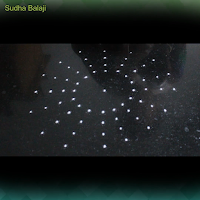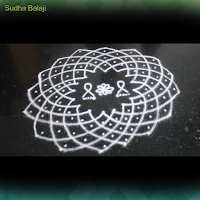Draw this traditional rangoli for festival Puja . The beauty of this kolam is that the lines are drawn just outside the dots , curved lines that is . So when the muggu is completed we can see a beautiful pattern of dots. This design too belong to the lotus kolam variety. Apart from Diwali we can draw in the Pooja room for Friday and auspicious festivals like Dasara
Place 4 dots in 16 directions
From the inner most dot draw lines outside dots as shown
Using the inner most dots connect the edges of the lines. A different type of chukki rangoli
Decorate with kaavi ( geru ). Draw
Feet of Goddess Lakshmi welcoming Her inside. Also, we can imagine that the Feet represent Lakshmi Maa who is standing in the kolam making it more auspicious.
If you are looking for rangoli for Pooja ghar you can try this. Decorating it with this design the Puja ghar or mandir should give positive vibes.
This category of rangoli designs with dots with s circular dot grid expanding radially can be used to create beautiful patterns. Some of them are commonly used and have been handed over from one generation to the next.
A few have been created by me or modified /improved (in my opinion) or shall I say extensions or decorations added to the original pattern according to my imagination.
Such traditional patterns are a feast to the eyes and with minimum colours with skill and dexterity only coming into play. I think you will agree.
Place the circular dot grid by placing dots in four directions then placing dots between any two and finally adding two more between any two.
This will ensure that we will get a near uniform dot grid such that the angles from the centre to all the dots is almost uniform - as humanly as possible without the aids like a a protractor.
Next image shows how the lines are drawn among the dots without touching them. Two sets are drawn as shown.
Complete with Goddess Lakshmi Feet, fill the design with a few colours. Diwali decoration for
Laxmi Pujan is ready.
These ideas can be used for chukki rangoli for Diwali







Comments